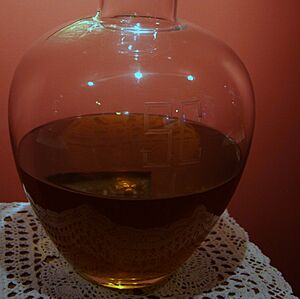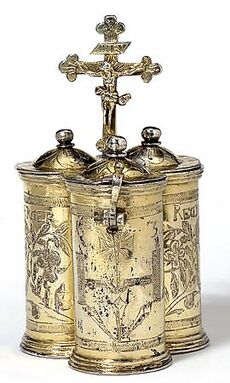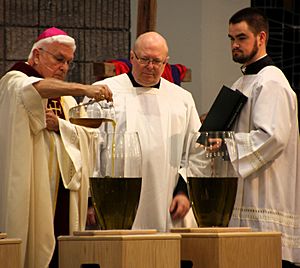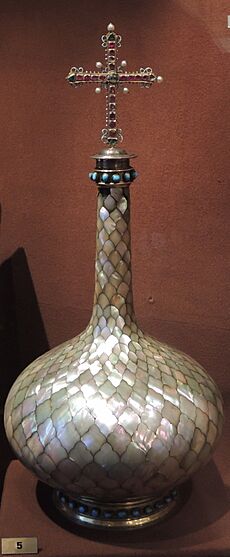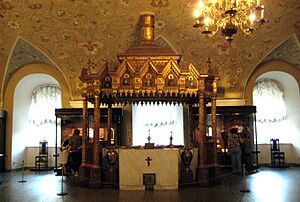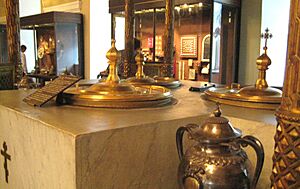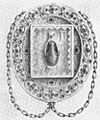Chrism facts for kids
Chrism is a special, blessed oil used in many Christian churches. It's also known as myrrh, myron, holy anointing oil, or consecrated oil. Churches like the Catholic, Eastern Orthodox, Anglican, and Lutheran churches use chrism. It's important for certain sacraments and church ceremonies.
Contents
What is Chrism?
The word "chrism" comes from an old Greek word, khrîsma. This word meant "anointing" or "the act of putting oil on someone." Later, it also came to mean the special oil itself. This word traveled through Latin and Old French to become "chrism" in English.
Chrism is often made from olive oil. It usually has a sweet smell from perfumes like balsam. This special oil is blessed by a bishop during a church service.
Early Christian Use
Early Christians talked a lot about using chrism. Documents from people like Theophilus of Antioch and Tertullian mention it.
Cyril of Jerusalem wrote in detail about how chrism was used. He said it was put on the forehead, ears, nostrils, and chest. Cyril taught that this oil was a "seal of the covenants." It showed God's promises to Christians. Being anointed with chrism was a sign of being a Christian. It also showed that a person had received the Holy Spirit. This meaning is still important in many churches today.
Western Christianity
Catholic Church
Chrism is very important in the Catholic Church. It's used in the sacrament of Confirmation. During Confirmation, a bishop or priest anoints the person's head with chrism.
It's also used in baptism. If someone baptized isn't confirmed right away, they are anointed with chrism. When new priests are ordained, their hands are anointed with chrism. New bishops have their foreheads anointed. Chrism is also used to bless church buildings and altars.
In the past, chrism was used to bless patens and chalices. These are the plates and cups used for the eucharist. Now, a simple blessing is usually enough. But a bishop can still use chrism for this if they choose.
Chrism is usually blessed by the bishop of an area. This happens during the Chrism Mass. This special Mass often takes place on Maundy Thursday (the Thursday before Easter). Other holy oils, like the oil of catechumens and the oil of the sick, are also blessed then.
These holy oils are kept in special containers called chrismaria. These are stored in a cabinet called an ambry. Priests use smaller containers with three parts, called "oil stocks," to carry the oils. Some oil stocks are even shaped like rings for easy anointing.
Chrism was also used in the past to anoint kings during their coronation ceremonies. For example, in France, a special oil from the Holy Ampulla was mixed with chrism. This mixture was used to anoint the kings of France. The Holy Ampulla was a glass vial said to hold oil used to baptize the first French king, Clovis I.
Anglicanism and Lutheranism
In Anglican and Lutheran churches, chrism is mainly used for chrismation. This is a rite that can be part of baptism, even for babies.
Chrism is also often used in confirmation. However, some churches in these groups don't use it for confirmation. The Church of England says that chrism "may be used" during confirmation. It shows the blessings of the Holy Spirit.
Chrism can also be used when priests or bishops are ordained. For example, in the Church of England, a bishop "may anoint the palms" of new priests. Bishops are anointed on the head.
A very important use of chrism is during the coronation of the British monarch. The Archbishop of Canterbury anoints the king or queen on the head, hands, and heart. This is seen as the holiest part of the service. It is even hidden from public view by screens or canopies. For example, it was not filmed during the coronation of Queen Elizabeth II in 1953.
Chrism is also used when new church buildings are consecrated. It can be used to anoint the walls, the altar, and the place where the eucharist is kept.
Like in other traditions, chrism is usually made from olive oil. It's scented with sweet perfumes like balsam. For the coronation of King Charles III in 2023, the oil was scented with essential oils like sesame, rose, and jasmine.
Bishops usually consecrate chrism during a special service on Maundy Thursday. Some Lutheran and Anglican churches allow a pastor who is not a bishop to consecrate chrism if needed. The oil for King Charles III's coronation was blessed in Jerusalem.
Latter Day Saints
Members of the Latter Day Saint movement also use blessed oil for anointing. This is especially for blessing the sick. They call this an "ordinance."
Members of the Church of Jesus Christ of Latter-day Saints who hold the Melchizedek priesthood can use consecrated oil. They put a drop of oil on the person's head. Then they lay their hands on the head and say a blessing. They can consecrate pure olive oil themselves. They do not use the word "chrism."
Eastern Christianity
Eastern Orthodox Church
In the Orthodox Church, chrism is used in many services. It's part of the sacrament of chrismation. This sacrament usually happens right after baptism. The bishop's blessing of the chrism acts like the laying on of hands. Chrism is also used to bless new church buildings and altars. In the past, emperors and kings in Orthodox countries were anointed with chrism at their coronations.
The Orthodox Church makes chrism during Holy Week. This starts on Holy Monday and ends on Maundy Thursday. The chrism is made mainly from olive oil. Many aromatic essences are added, like the anointing oil described in the Bible. Only a bishop can make holy chrism.
In Russia, a few drops of old chrism are added to the new batch. This shows the connection of the Russian Church to the Greek Church. Chrism is not made every year. It's only made when supplies are low.
The Orthodox Patriarchate of Constantinople makes chrism about every 10 years. They use an old recipe with 64 ingredients. The fire to boil the mixture is made by burning old icons. Special people called Kosmētores Myrepsoí (Deans Perfumers) prepare the chrism. They are led by the Árchōn Myrepsós (Lord Perfumer). Regular church members are not allowed to touch the chrism or its containers. So, the Myrepsoi are given a special "temporary ordination" for their four-day service.
Three copper pots are used for making chrism. The largest holds olive oil. The smallest holds water and the aromatic ingredients. The middle pot holds wine, which helps the oil boil safely. The patriarch himself adds some ingredients like musk and rose oil. Once the chrism is ready, it is filtered and blessed one last time. Then it is stored in silver containers.
Oriental Orthodox Churches
In the Malankara Orthodox Syrian Church, they believe Christ taught the apostles how to bless chrism. Usually, the head of the church blesses it. He wears white clothes to show purity. Twelve priests are present, representing the twelve apostles. Twelve censers, lamps, and fans are also used.
The Armenian Apostolic Church blesses chrism every seven years. This happens in the autumn at Etchmiadzin Cathedral in Armenia.
See also
 In Spanish: Crisma para niños
In Spanish: Crisma para niños
Images for kids


